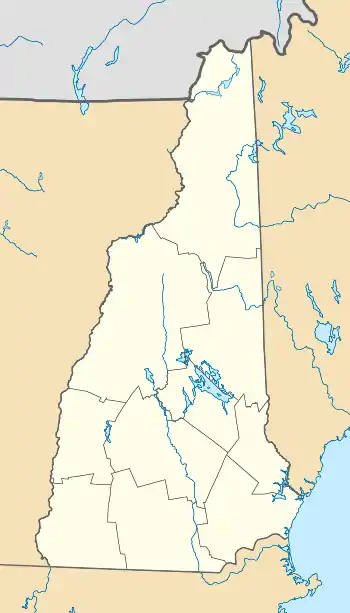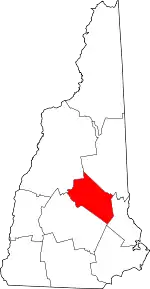John J. Morrill Store
The John J. Morrill Store is a historic store and Grange hall on Belknap Mountain Road in the central village of Gilford, New Hampshire. Built in the late 1850s, it is a well-preserved example of a period general store with Greek Revival features. The building has also served as the local post office and as a Grange hall. It was listed on the National Register of Historic Places in 1980.[1]
John J. Morrill Store | |
 | |
  | |
| Location | Belknap Mountain Rd., Gilford, New Hampshire |
|---|---|
| Coordinates | 43°32′52″N 71°24′23″W |
| Area | 0.2 acres (0.081 ha) |
| Built | 1857 |
| Architectural style | Greek Revival |
| NRHP reference No. | 80000266[1] |
| Added to NRHP | August 29, 1980 |
Description and history
The former Morrill Store building is located in the center of Gilford village, at the northwest corner of Belknap Mountain Road and Potter Hill Road. It is a 2+1⁄2-story wood frame clapboarded structure with a gable roof. It is predominantly Greek Revival in style, with pilastered corner boards, and with entablatures and friezes above. A shed-roof porch extends across the main facade, supported by simple brackets. The first floor of the facade has two entrances: a nearly central double-leaf entry flanked by display windows, and a single-leaf entry at the left side, which provides access to the upper floors. A two-story frame addition extends to the left of the main block, with a 1+1⁄2-story addition extending further from that.[2]
The structure was built as a general store in the late 1850s by John Morrill, but the business only lasted a few years. For this use, the ground floor served as the shop, and the upper floor was a storeroom. It served for many years as the local post office, and was purchased by the local Grange organization in 1909. That organization made a series of interior alterations to facilitate its use, converting the retail space into a kitchen and dining hall. In later years it added modernizations, including a modern heating plant. In the 1950s the end wing was adapted for use by the Junior Grange.[2]
References
- "National Register Information System". National Register of Historic Places. National Park Service. July 9, 2010.
- "NRHP nomination for John J. Morrill Store". National Park Service. Retrieved 2014-08-26.
